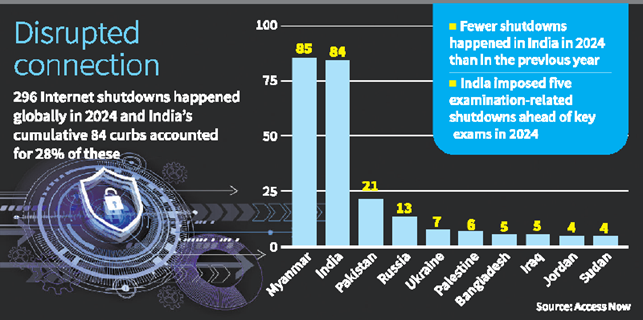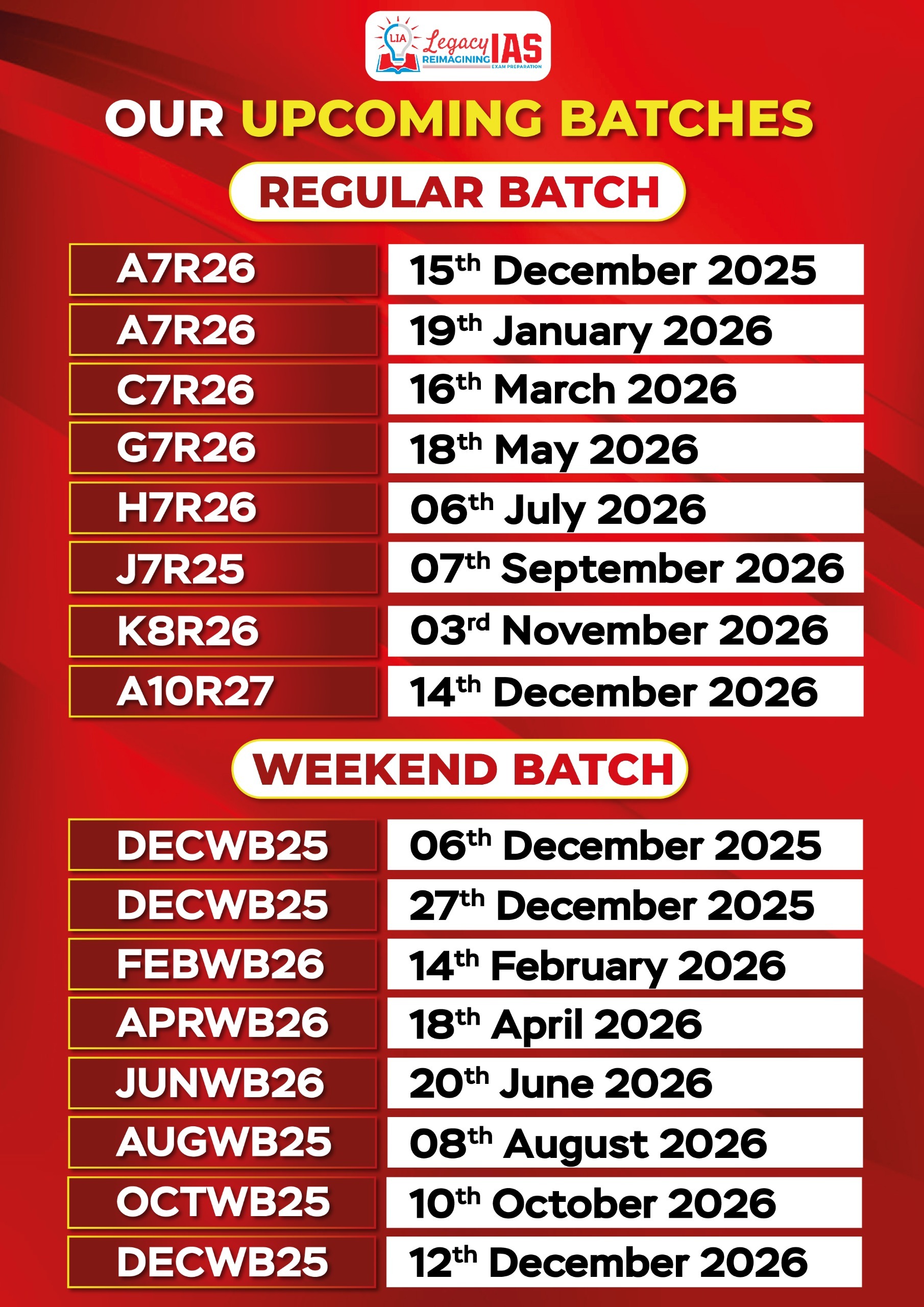Content:
- Internet shutdowns highest in 2024 globally, India tops in government-ordered curbs
- Remarkable rise in India’s social security coverage: ILO chief
- How does space travel affect health of an astronaut?
- The UGC’s mandate is to elevate, not strangulate
- Why are pilots asking for more rest hours?
- Indian tech industry revenue projected to grow 5.1% even as job loss concerns persist
- Surveillance capitalism: the power to control personal data
Internet shutdowns highest in 2024 globally, India tops in government-ordered curbs
Global Context:
- 2024 witnessed 296 global Internet shutdowns, the highest ever.
- India accounted for 28% of global shutdowns with 84 instances, second only to Myanmar (85).

Relevance : GS 2(Governance)
India-Specific Insights:
- Government Role: Union and State governments in India led in government-ordered shutdowns globally.
- Regional Breakdown:
- Manipur: 21 shutdowns
- Haryana: 12 shutdowns
- Jammu & Kashmir: 12 shutdowns
- Reasons for Shutdowns:
- Protests: 41 instances
- Communal violence: 23 instances
- Exam-related curbs: 5 instances (criticized as disproportionate)
Notable Exam-related Shutdowns:
- Jharkhand: During Graduate Level Competitive Exams (5.5 hours, Sept 22)
- Assam: For government job exams (Sept, most districts)
- Rajasthan: For Public Service Commission exam (Jan)
Myanmar Comparison:
- Myanmar topped with 85 shutdowns.
- Some imposed by external actors like China (2), Thailand (4), and local armed groups (NUG, MNDAA, TNLA).
Advocacy Concerns:
- Access Now: Criticized exam-related shutdowns as excessive measures.
- Broader concerns on freedom of speech, digital rights, and democratic implications.
Trend Observation:
- India’s shutdowns decreased from 2023 but remain disproportionately high.
- Global rise in shutdowns indicates increasing digital control during unrest and sensitive events.
Remarkable rise in India’s social security coverage: ILO chief
Key Highlights:
- India’s social protection coverage increased from 24% to 49%, nearly doubling in a short span.
- Data sourced from the World Social Protection Report 2024-26 by the International Labour Organization (ILO).
Relevance : GS 1(Society ), GS 2(Social Issues , Governance)
ILO’s Observations (Gilbert F. Houngbo, Director-General):
- Commended the strong India-ILO partnership and decisive government actions.
- Highlighted India’s balanced focus on business growth and social protection as a global model.
- Appreciated digital initiatives like e-Shram for expanding employment opportunities and social security coverage.
- Lauded India’s commitment to inclusive economic growth.
Significance and Implications:
- Improved social protection fosters inclusive growth and reduces vulnerability.
- Digital platforms enhance accessibility, transparency, and efficiency in welfare delivery.
- Strengthened labour welfare measures can lead to improved human capital development and productivity.
Broader Context:
- India’s progress aligns with global efforts toward achieving social justice and sustainable development goals (SDGs).
- The Regional Dialogue on Social Justice serves as a platform to exchange best practices and strengthen global cooperation.
How does space travel affect health of an astronaut?
Environmental Challenges in Space:
- Space presents microgravity conditions and high-energy radiation exposure, unlike Earth.
- Lack of Earth’s atmospheric and magnetic protection increases health risks, especially beyond low-earth orbit (e.g., Moon missions).
Physiological Effects of Space Travel:
- Radiation Exposure:
- Leads to DNA damage, increased cancer risk, neurodegeneration, and immune system dysregulation.
- Microgravity Effects:
- Fluid shifts upward → Increased intracranial pressure affecting vision.
- Bone and muscle loss due to absence of mechanical loading → Bone density loss, muscle atrophy.
- Cardiovascular changes → Difficulty regulating blood pressure upon return.
- Inner ear dysfunction → Balance and coordination issues.
- Vision Impairment:
- Linked to spaceflight-associated neuro-ocular syndrome from fluid shifts and intracranial pressure changes.
Psychological and Behavioral Challenges:
- Isolation and confinement → Psychological stress, mood disorders, and sleep disturbances.
- Limited social interaction and absence of natural stimuli aggravate mental health challenges on long-duration missions.
Recovery After Space Missions:
- Short-duration missions (few days):
- Approximately 95% of biological damage reverses post-return.
- Long-duration missions (months):
- Recovery correlates with time spent in space.
- Some physiological functions gradually normalize, but vision and certain neurological issues may persist.
Need for Countermeasures:
- Focus on developing personalized risk profiles and targeted mitigation strategies.
- Researchers emphasize collecting more data from astronauts with diverse health backgrounds and mission types.
Broader Implications:
- Ensuring astronaut health is crucial for future deep-space explorations (e.g., Mars missions).
- Continued research aims at balancing human endurance limits with space exploration ambitions.
The UGC’s mandate is to elevate, not strangulate
Context:
- UGC’s recent directive on the appointment procedure of vice-chancellors (VCs) has faced resistance from states like Kerala and Tamil Nadu.
- States argue that the directive infringes on their constitutional prerogatives and promotes central overreach through Governor-appointed VCs.
Relevance :GS 2(Education , Governance , Polity)
Key Points of Contention:
- Federalism Concerns:
- States fund and establish universities, asserting that elected state governments should have the final say.
- The increasing role of Governors (appointed by the Centre) in appointing VCs is seen as undermining state autonomy.
- UGC’s New Qualification Norms for VCs:
- Rescinds the requirement for VCs to be solely from academic backgrounds.
- Opens eligibility to distinguished individuals from fields like industry, politics, and journalism.
- Global and Indian Examples:
- International: Oxford, Cambridge, and U.S. universities often appoint non-academics as heads.
- India: G. Parthasarathy’s successful tenure as JNU’s first VC.
Critique of the UGC’s Broader Role:
- Deviation from Core Mandate:
- Established in 1956 to maintain higher education standards but focuses more on uniform regulations than quality improvement.
- Persistent concerns over the poor quality of graduates, as highlighted by judiciary and industry leaders.
- Overemphasis on Procedural Controls:
- Excessive regulation on attendance, faculty hours, record-keeping, and curriculum decisions.
- Resembles colonial-era surveillance practices, limiting institutional autonomy and faculty agency.
- Result: Faculty disengagement and decline in accountability for learning outcomes.
- Impact on Higher Education Quality:
- Despite economic growth, public universities have declined in global stature.
- India lags in research and innovation, with little presence in global knowledge production (e.g., AI advancements like China’s DeepSeek).
Broader Implications:
- Micro-management and Political Interference:
- High compliance burdens and politicization hinder academic excellence and research output.
- Need for Structural Reforms:
- UGC should shift focus from procedural oversight to elevating teaching quality, research, and global competitiveness.
Conclusion:
- While expanding eligibility for VCs is a progressive step, the UGC’s overarching micro-management stifles innovation and institutional growth.
- Strengthening autonomy, reducing political interference, and prioritizing educational excellence are key to reviving India’s higher education system
Why are pilots asking for more rest hours?
Delhi High Court Ruling
- New norms to be implemented: Liberalised duty and rest norms by DGCA (Jan 2024) to come into effect from July 1, 2025.
- Key provisions effective July 2025:
- Weekly rest increased from 36 to 48 hours.
- Airlines must submit quarterly fatigue complaint reports.
- Provisions effective by Nov 1, 2025:
- Night duty redefined: 00:00–06:00 hrs (earlier 00:00–05:00 hrs).
- Cap on landings: Max two landings during night duty.
- Reduced duty hours: Max 8 hours flying or 10 hours total duty on night duty.
- Special dispensation time reduced: From 3 hours to 2 hours in unforeseen circumstances.
Relevance : GS 2 (Social Issues) , GS 1(Society)
Why did pilots demand more rest?
- Increased workload post COVID-19:
- Upto 4 landings/day; 10 hours flying, 12–13 hours total duty.
- Approaches and landings demand high concentration.
- Circadian rhythm disruption:
- Two consecutive night flights affect natural body clock.
- 02:00–06:00 hrs toughest window (circadian low).
- Rosters issues:
- Erratic schedules: Sudden shift changes affect rest planning.
- Example: 10 AM duty changed to 4 PM ending at 2 AM, disrupting rest cycles.
- Cockpit conditions causing fatigue:
- Poor air flow, restricted movement, low light, noise, and pressure changes.
- Pilots often sleep 1.5–2.5 hours inside cockpit during short-haul flights.
Leave and Duty Structure
- Monthly flying hours: 50–90 hours; Total duty: 140–150 hours.
- Leave entitlements:
- Air India: 6 casual, 12 sick, 30 privilege leaves (PL) (apply a year in advance).
- IndiGo: 42 PLs (Captains), 22 PLs (First Officers).
- Weekly rest: Only on the 8th day (as per DGCA norms).
- No public holidays for pilots.
Why did airlines oppose the relaxed rules?
- Operational challenges:
- Need to hire more pilots → Increased costs & time.
- Potential flight cancellations and fare hikes.
- Cost pressures:
- Post-pandemic: Higher airport tariffs and lease costs (+20–30%).
- Crew expenses: 3rd largest airline cost (8.7%).
- Airline profit margins slim: $7 profit/passenger (IATA, 2025 projection).
Airline Responses
- Air India:
- Claims robust Fatigue Risk Management (FRM) system in place.
- Uses Jeppesen Boeing Alertness Model (BAM) for fatigue analysis.
- Maintains a non-punitive, confidential fatigue reporting system.
- Has 3,500+ pilots—claims adequate staff for existing fleet.
- IndiGo: No official comments on fatigue management practices.
Triggering incidents & pilot concerns
- Pilot deaths: IndiGo pilot’s cardiac arrest (Aug 2023) highlighted fatigue risks.
- Reduced pay driving longer hours:
- Air India’s fixed pay now 40 flying hours (down from 70 hours) → Pilots fly more to earn.
- International comparison:
- DGCA norms based on U.S. & EU standards but Indian pilots lack union negotiation rights.
Future Outlook
- Demand for pilots rising:
- India’s fastest-growing aviation market; 1,000 aircraft on order (Air India & IndiGo) by 2035.
- Need for pilot utilisation vs. fatigue management will intensify.
Bottom line: Pilots are seeking more rest due to excessive workloads, erratic rosters, and circadian disruption impacting safety and health. Airlines cite operational and cost concerns but face pressure to prioritise pilot well-being amidst rising travel demand.
Indian tech industry revenue projected to grow 5.1% even as job loss concerns persist
Revenue Projections:
- Indian tech industry revenue projected to grow 5.1% to $282.6 billion in FY 2025-26 (NASSCOM Annual Strategic Review 2026).
- Domestic revenue to grow faster at 7% to $58.2 billion, while exports projected at 4.6% growth.
- IT Services and Engineering R&D to continue dominating revenue share.
Relevance : GS 3(Economy)
Job Market & Hiring Trends:
- Despite revenue growth, 55% of surveyed CEOs expect hiring to plateau or reduce in FY26.
- AI adoption prompting companies to prioritize technology spending over human resources.
- Concerns over job shrinkage due to AI are increasing.
Artificial Intelligence (AI) Focus:
- Around two-thirds of CEOs project over 10% of tech spending on AI.
- CEOs of HCL and Infosys urge firms to approach AI adoption with “paranoia” to avoid complacency and ensure competitiveness.
- Maharashtra aims to become an AI hub to support its $1 trillion economy target .
Upskilling & Strategic Vision:
- Upskilling in niche tech areas emphasized as crucial for industry sustainability (Rajesh Nambiar, NASSCOM President).
- Sustaining growth requires a strategic vision beyond just AI investment.
Government Initiatives & Competitiveness:
- Positive response to tender for 10,000 GPUs, with 18,000 orders placed at less than $1 per unit.
- Stressed the need to maintain industry competitiveness through proactive efforts by NASSCOM and government.
Key Takeaways:
- Revenue growth remains robust but job growth lags amid AI-driven disruptions.
- Skill development and balanced tech adoption are vital to navigate emerging challenges.
- India’s tech competitiveness hinges on AI leadership and domestic market expansion.
Surveillance capitalism: the power to control personal data
What is Surveillance Capitalism?
- Economic system where personal data is commodified to predict and influence human behaviour.
- Coined by Shoshana Zuboff in The Age of Surveillance Capitalism (2018).
- Relies on tracking online/offline activities (clicks, searches, purchases, movements).
- Companies involved: Google, Meta, Amazon, etc.
Relevance : GS 3(Economy, Technology)
How It Works:
- Data extraction: Human experience converted into data.
- Predictive analytics: Algorithms predict behaviour, guiding user choices.
- Instrumentarian power: Control through subtle behavioural nudges (not coercion).
- Social physics (Alex Pentland): Studies human interaction patterns for behavioural prediction.
Differences from Industrial Capitalism:
- Industrial Capitalism: Focus on production, labour exploitation, efficiency.
- Surveillance Capitalism: Focus on data extraction, behavioural manipulation, user engagement.
- Users become both consumers and raw data sources.
Role of State Surveillance:
- Corporation-state collaboration: Tech firms provide data to governments.
- Data-sharing agreements often bypass democratic accountability.
- Example: States leverage private surveillance for intelligence and policing.
Impact on Privacy and Autonomy:
- Erosion of autonomy: Users’ decisions influenced by targeted content.
- Behavioural conditioning: Algorithms subtly manipulate user preferences.
- Example: Cambridge Analytica scandal (2014) – Exploited Facebook data to influence US elections.
Regulatory Challenges:
- Existing laws:
- EU’s GDPR: Data privacy focus but doesn’t curb commodification.
- India’s DPDPA: Aims for user control but lacks structural oversight.
- Obstacles:
- Corporate lobbying and political influence weaken regulations.
- Rise of tech leaders in politics protects corporate interests.
Way Forward:
- Stronger regulations: Limit data commodification, increase accountability.
- Public awareness: Encourage critical engagement with digital platforms.
- Policy focus: Move beyond data privacy to address structural exploitation.
Key Concerns:
- Loss of individual privacy and autonomy.
- Growing corporate-political nexus controlling digital ecosystems.
- Systemic fragility: Data breaches can trigger financial and information crises.



